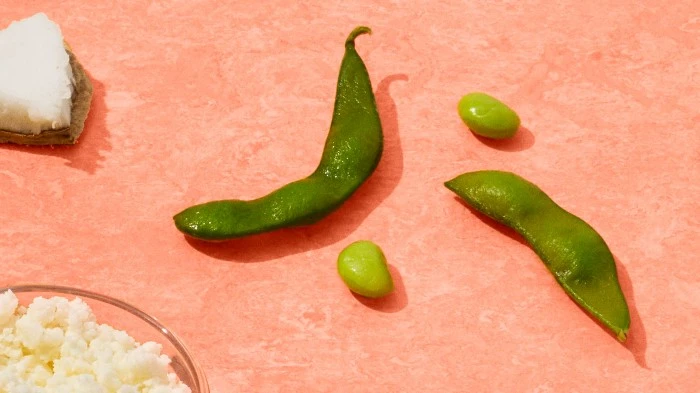Soy: Facts, Myths and Why It’s In Our Products
By Sue Klapholz, MD, PhD — VP of Nutrition, Health & Food Safety at Impossible Foods.

Impossible™ Beef Made From Plants is sold as Impossible ™ Burger in the US and product and environmental information may not be the same for New Zealand.
Soy has been consumed for centuries and researched extensively. In fact, over 15,000 peer-reviewed articles have been written about its impact on health and nutrition.
The soybean is notable among plants for its “high quality” protein, and is the only commonly consumed plant protein that is comparable in quality to animal protein.¹ In most cases, “quality” is defined in terms of protein digestibility-corrected amino acid score (PDCAAS), which takes into account the protein’s essential amino acid composition and digestibility. Published PDCAAS values for soy protein range from 0.91 to 1.0, depending upon the specific soy product.² Soy protein concentrate — the ingredient that provides the majority of protein in Impossible™ Burger and Impossible™ Sausage Made from Plants — has a published PDCAAS of 0.99.³ For reference, beef from cows has a PDCAAS of 0.92.³
Soy is rich in fiber and is also a good source of several essential minerals, including magnesium, potassium, phosphorus, and iron.¹
While the scientific consensus supports the health benefits of soy, concerns have risen about its safety — that have zero or little basis in fact. These include claims that soy causes breast cancer, decreases male fertility and interferes with thyroid function. Though many of them are based in myth, concerns are concerns, and we’ll go through them one by one.
First, some basics on phytoestrogens and isoflavones.
A number of myths are derived from the fact that soybeans are a rich source of “isoflavones,” a type of “phytoestrogen” or plant estrogen.
Phytoestrogens are compounds found in a wide variety of plants — not just soy — that get their name because they are structurally similar to 17-β-estradiol, the primary female sex hormone. Phytoestrogens can bind estrogen receptors (ERs) in vitro, where they may exert mild estrogen promoting (“agonist”) and/or blocking (“antagonist”) effects. In cell culture, phytoestrogens actually preferentially bind to one type of estrogen receptor, ER ß, which appears to be associated with anti-proliferative, anti-carcinogenic (i.e., cancer-protective) effects.
Some of the main classes of phytoestrogens include isoflavones (found in soy), lignans (the most common type of phytoestrogen in the human diet, found in fiber-rich foods like flax and sesame), coumestans (split peas, pinto beans, clover sprouts), prenylflavanoids (hoppy beverages like beer and ale) and resveratrol (wine, peanuts, berries, cocoa).
Isoflavones are the source of some of the most commonly expressed health concerns around soy. Yet, no systematic well-controlled human studies have shown adverse effects of soy isoflavones on human health.⁴ ⁵
Mean dietary levels of isoflavones range from 25–50 mg per day in Asian countries to only 1–3 mg per day in Western countries.⁴ ⁵ At typical Asian dietary levels, it isn’t clear that soy isoflavones have any effect on human health. Even at the higher isoflavone levels found in supplements used to treat menopausal symptoms (35–150 mg), the European Food Safety Authority found no cause for concern.⁵ And to put these numbers in perspective, a 4-oz. serving of Impossible Burger contains under 2 mg of isoflavones.
Nevertheless, here are the top three myths about soy and soy isoflavones.

Myth #1: Eating soy can increase a woman’s risk of developing breast cancer.
There’s no scientific evidence that consuming soy increases breast cancer risk. On the other hand, there is evidence from many large epidemiological studies that soy consumption reduces the risk of breast cancer.⁶ ⁷ These studies show that consumption of soy early in life and at the higher levels typical of Japanese diets (6–11 g soy per day) provides the most consistent protective effect. In addition, a number of studies suggest that incorporating soy into the diet of breast cancer survivors decreases their risk of recurrence.
Bottom line: Soy has a protective — or at worst, neutral — effect on breast cancer risk.
Myth #2: Soy affects male hormone levels and/or fertility.
Controlled studies have demonstrated that neither soy protein nor isoflavones affect reproductive hormone concentrations (testosterone or estrogen) in men — even as the amount of soy protein or isoflavone supplements consumed in these studies greatly exceeded typical dietary intake.⁸ ⁹ ¹⁰
There are two case reports in the medical literature that have gotten some attention: one is of a man who developed excessive breast tissue (gynecomastia) and the other is of a man who experienced sexual dysfunction, due to diets that consisted of extremely high levels of soy — equivalent to three quarts of soy milk per day — over long periods of time. However, in both cases, symptoms resolved upon discontinuing soy. And in multiple other controlled scientific studies, no consistent association was found between soy intake and parameters of male fertility, such as sperm concentration and motility.¹¹
Bottom line: Typical levels of soy consumption have no adverse effects on male hormone levels or fertility.

Myth #3: Soy interferes with thyroid function.
Well-controlled clinical trials have also examined the effects of soy foods and/or isoflavones on thyroid function in healthy subjects.¹² Either no effects or clinically insignificant changes in thyroid hormone levels were noted in these trials. More specifically, for those undergoing synthetic thyroid hormone replacement therapy: A number of food constituents, including soy, fiber, walnuts and calcium can decrease thyroid hormone bioavailability by interfering with its absorption. People on thyroid hormone replacement therapy can simply avoid these possible food interactions by taking their medication on an empty stomach.
Bottom line: Soy consumption has no adverse effect on normal thyroid function.
To eat or not to eat
Soy has a long history of safe use in food, including infant formula — barring individual allergies. The soy in Impossible Burger and Impossible Sausage Made From Plants is a source of high quality protein, dietary fiber, and essential micronutrients.
Soy is not only safe; it’s accessible, nutritious for adults and children — and when used right — delicious. So why put it in our recipe? We ask: why not?
More questions? Contact us at [email protected].
References:
Messina, M. Soy and Health Update: Evaluation of the Clinical and Epidemiological Literature. Nutrients 2016, 8(12), 754.
Hughes, G.J.; Ryan, D.J.; Mukherjea, R.; Schasteen, C.S. Protein digestibility-corrected amino acid scores (PDCAAS) for soy protein isolates and concentrate: Criteria for evaluation. J. Agric. Food Chem. 2011, 59, 12707.
Protein Quality Evaluation. Report of Joint FAO/WHO Expert Consultation 2001.
Higdon, J.; Drake, V.J.; Delage, B. Soy isoflavones. Oregon State University Linus Pauling Institute, updated August, 2016, https://lpi.oregonstate.edu/mic/dietary-factors/phytochemicals/soy-isoflavones(opens in a new tab)
EFSA Panel on Food Additives and Nutrient Sources added to Food. Risk assessment for peri- and post-menopausal women taking food supplements containing isolated isoflavones. EFSA Journal 2015, 13(10), 4246.
Fritz, H.; Seely, D. ; Flower, G.; Skidmore, B.; Fernandes, R.; Vadeboncoeur, S. Kennedy, D.; Cooley, K.; Wong, R.; Sagar, S.; Sabri, E.; Dean Fergusson, D. Soy, Red Clover, and Isoflavones and Breast Cancer: A Systematic Review. PLoS ONE 2013, 8(11), e81968.
Wu, J.; Zeng, R.; Huang, J.;Li, X.;Zhang, J.; Ho, J.C.; Zheng, Y. Dietary Protein Sources and Incidence of Breast Cancer: A Dose-Response Meta-Analysis of Prospective Studies. Nutrition 2016, 8, 730.
Hamilton-Reeves, J.M.; Vazquez, G.; Duval, S.J.; Phipps, W.R.; Kurzer, M.S.; Messina, M.J. et al. Clinical studies show no effects of soy protein or isoflavones on reproductive hormones in men: results of a meta-analysis. Fertil. Steril. 2010, 94(3), 997.
Habito, R.C.; Montalto, J.; Leslie, E.; Ball, M.J. Effects of replacing meat with soybean in the diet on sex hormone concentrations in healthy adult males. Br. J. Nutr. 2000, 84, 557.
Reed, K.E.; Camargo, J.; Hamilton-Reeves, J.; Kurzer, M.; Messina, M. Neither soy nor isoflavone intake affects male reproductive hormones: An expanded and updated meta-analysis of clinical studies. Reprod.Toxicol. 2021, 100, 60.
Mitchell, J.H.; Cawood, E.; Kinniburgh, D.; Provan, A.; Collins, A.R.; Irvine, D.S. Effect of a phytoestrogen food supplement on reproductive health in normal males. Clin. Sci. (Lond.) 2001, 100, 613.
Messina, M.; Redmond, G. Effects of Soy Protein and Soybean Isoflavones on Thyroid Function in Healthy Adults and Hypothyroid Patients: A Review of the Relevant Literature. Thyroid 2006, 16(3), 249.